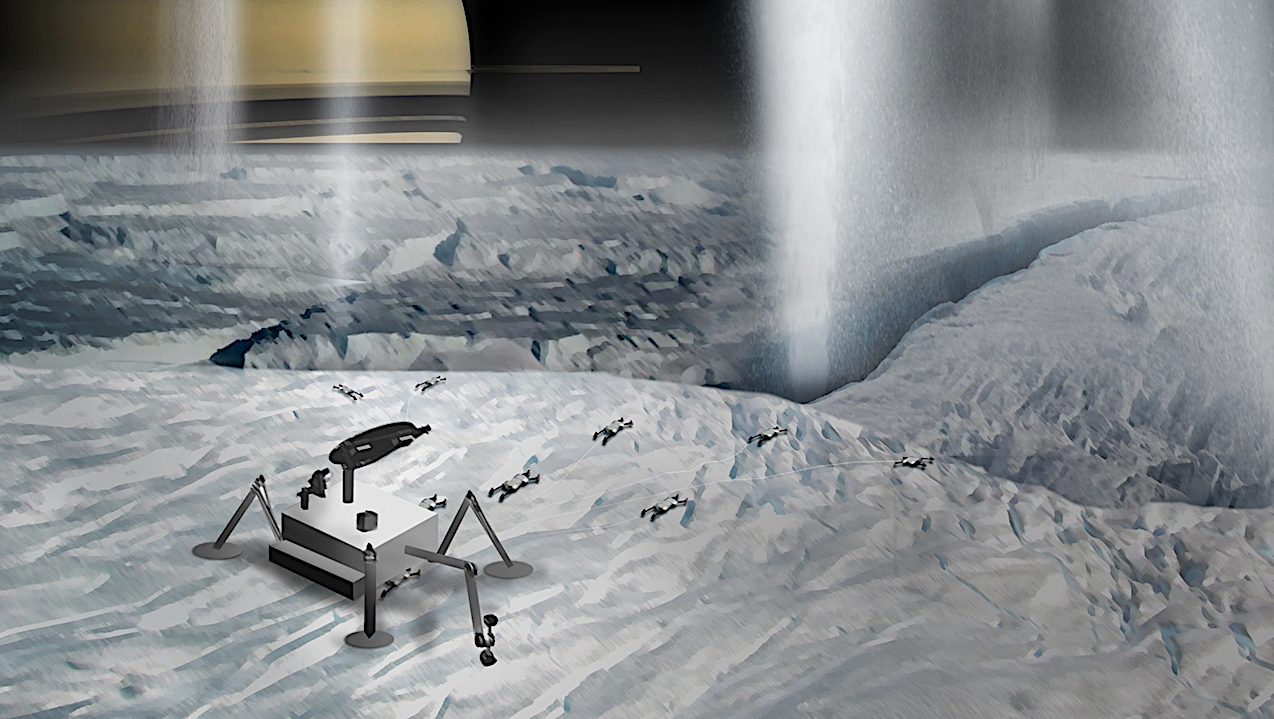
Enceladus Vent Explorer (EVE) – NIAC
The Enceladus Vent Explorer (EVE) is a robotic mission to enter Enceladus. His mission was to collect samples of ocean water that might contain intact organisms (i.e., cells) such as Enceladus and ii to come to a clear conclusion about the existence of life in the ocean) and if the result is positive, to classify the life. and the ecosystem of Enceladus through biochemical, taxonomic, phylogenetic and ecological studies.
An EVE mission will send two types of modules: Surface Module (SM) and Descending Module (DM). The SM is a lander that lands within a few hundred meters of the entrance to the blast vent. After a successful landing, it deploys a single or multiple DMs.
First, the DMs move to a vent and land in it. They use miniaturized instruments such as a microscopic imager and a microfluidics chip to conduct in-situ scientific studies in the atmosphere.
Finally, it collects seawater and/or ice particles in the vent and delivers them to instruments on the SM, such as a mass spectrometer, for detailed chemical analysis. These abilities can be carried by a single, relatively large DM or distributed among several smaller DMs.

Graphic depiction of the Enceladus Vent Explorer: Phase II concept. Credit: Masahiro Ono
The Phase I study had two main focuses: vent conditions and computer trade analysis. Regarding the former, we conclude that there are two possible eruption scenarios: relatively quiet „boiling” models, in which a quasi-static fluid interface boils where a plume and/or plume is fueled, and more energetic „cryovolcanic” models. , in which materials ascend and change phase within a negative pressure gradient.
We developed a 1-D thermo-fluidic model of the vent and obtained the worst-case dynamic pressure and vent width. Phase I system trade-off analysis concluded that TMs should have 2-D vertical movement. A point design of DM was developed, consisting of four 5-DOF joints with ice screw end effectors.
We performed ice chamber experiments, computational fluid dynamics studies, and finite element analysis to evaluate the performance of this point design. As a result, we concluded that this point design was feasible under boiling point eruption conditions, while the feasibility under cryovolcanic conditions was not determined due to potential kinetic pressure (10^3 – 10^7 Pa).
Phase II study will consist of four tasks. In Task 1, we refine the vent condition analysis through improved numerical and experimental studies, hoping to obtain tighter worst-case bounds. In Task 2, we will explore a broader trade space in vertical mobility, with particular emphasis on anchoring mechanism and mobility architecture.
We will include new technology concepts such as sublimation anchor and snakebot. Task 3 examines software features. Specifically, commercial studies of 1) multirobot systems and 2) subterranean autonomy will be based on recent advances from JPL’s entry to the DARPA Subterrainan (SubT) challenge. In Task 4, we will perform two system trade-off studies for two different burst scenarios.
We will first define science goals for each scenario, develop science traceability matrices and identify Level 1 science requirements. To identify Level 2 engineering requirements, we break down the Level 1 requirements based on the results of Tasks 2 and 3. Finally, Level 2 requirements are translated into a technology roadmap by identifying technology gaps.
If EVE is realized, it will not only directly confirm extraterrestrial life, but also enable its characterization. A comparative study of life on different worlds will provide clues to the origin of life. EVE is not just a mission to an Enceladus vent, but to the secret of life.
Enceladus Vent Explorer Concept NIAC Technical Description)
Our concept, the Enceladus Vent Explorer (EVE), is a robotic pathfinder mission to enter these doors. EVE’s goals are to descend into eruptive conduits up to ~2km depth, characterize the unknown interior structure of the vent-conduit system, assess access to the subsurface ocean through the vent-conduit system, reach the fluid interface, and conduct astrophysics and volcano studies of the vent-conduit system. EVE sends two types of modules: Surface Module (SM) and Descending Module (DM). The SM is a lander that remains on the surface, while tens of thousands of small (~3 kg, 10 cm wide and 30 cm long) DMs detach from the SM, move to a vent, and land on it. DMs rely on the power and communication link provided by the SM through a single cable. Because the DM’s payload size is so small, each DM can only carry a small piece of equipment. This range is filled with diversity. There are several types of TMs, all of which share a common operating system but have different tools. For example, a „scout DM” creates a 3-D map of a geyser system with its stereo cameras and structured light. A „sample return DM” collects particles and ice in the air and feeds it to a mass spectrometer in the SM. „In-Situ ScienceTM” consists of scientific instruments such as a microscopic imager and a microfluidics chip for biosignature detection. TMs can be sent sequentially or in parallel.
Astronomy

„Oddany rozwiązywacz problemów. Przyjazny hipsterom praktykant bekonu. Miłośnik kawy. Nieuleczalny introwertyk. Student.
